| Decline and Fall
Around 1926 things started to get a little
shakier, as if reflecting the problems which Nobel Industries were
having. In 1927 they amalgamated with Brunner Mond Limited to form ICI,
a vast conglomerate of which John Marston Limited was but a small part.
Initially this had little impact at the works, Sunbeamland remained
under the control of Sidney Bowers, and Works Manager, F. T. Jones. |
|
The company did not do badly under ICI, but
motorcycles were not their chief interest, and this was certainly
felt at Marstons, where 1927 became a year of uncertainty for the
workforce.
Of course the general depression did not help.
Motorcycle sales slumped and the company contracted. The machines
were still good ones, but they had undergone a great change, no
longer being the Rolls Royce of motorcycles, but a considerably less
highbrow machine.
Luckily John Marston had decided to begin producing radiators in
1906 for the growing car industry, initially in Temple Street, then
at Sunbeamland.
The radiators were a very popular product, and sold well,
eventually becoming the company's most important asset.
Radiators were not only made for road vehicles, versions were
available for aircraft, and industrial applications. |
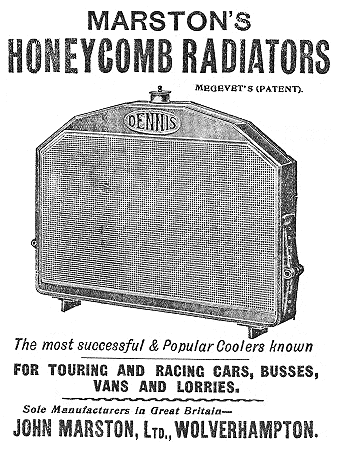
An advert from 1907. |
|
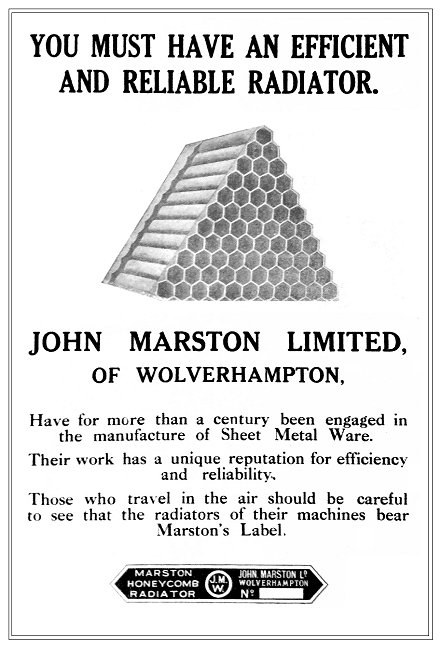
An advert from 1919. |
| An extension to the works |
|
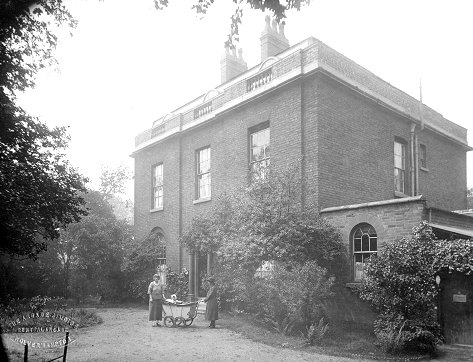
The Elms, Penn Road. |
On the opposite side of Penn Road to Sunbeamland stood an old
square red brick house called the Elms. It was built in the late
18th century, and was the family home of John Mander and his first
wife Esther. John was the founder of Mander Weaver and Company,
manufacturing chemists in Cock Street, Wolverhampton.
Because of John's profession, the house became known as "Gallipot
Hall" after the glazed earthen pots that were used for storing
medicines. |
|
The house had extensive grounds, and during the last years of
its life was known by many people as the doctor's surgery because it
was occupied by general practitioner, Dr. Brookes.
Around 1926 the
house and grounds were purchased by John Marston Limited to make way
for a new factory building.
The house was demolished in September, 1926.
|
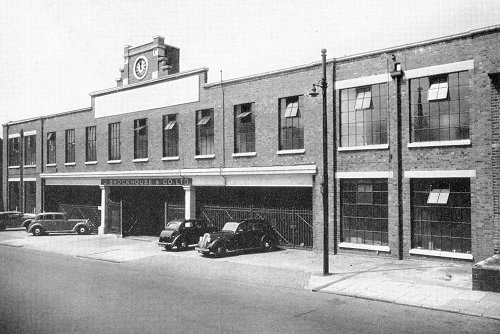
The Elms Works in the mid 1950s. |
|
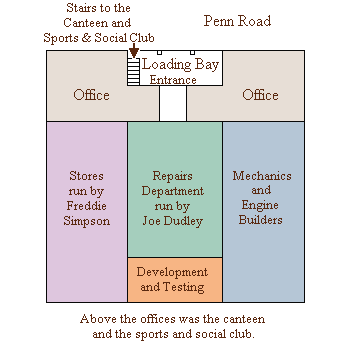
A plan of Elms Works. |
The new building, known as Elms works,
or Clock Works because of the clock on the roof, opened in 1928. It contained the Service and Spares Department run
by Joe Dudley, the stores run by Freddie Simpson, the Competition
Department, the canteen and Social Club, and offices. At
the time, the staff were actively encouraged to participate in
social and sporting activities outside working hours. As a result
the Sports and Social Club upstairs acquired snooker tables, and
became the meeting place of many sports teams, and even the
'Beamers' dance orchestra. Sporting activities included bowling,
cricket, fishing, football, and tennis.
The canteen was also the site of the official celebrations when
Charlie Dodson won the Isle of Man Senior T.T. in 1928. This was the
company's third T.T. win. |
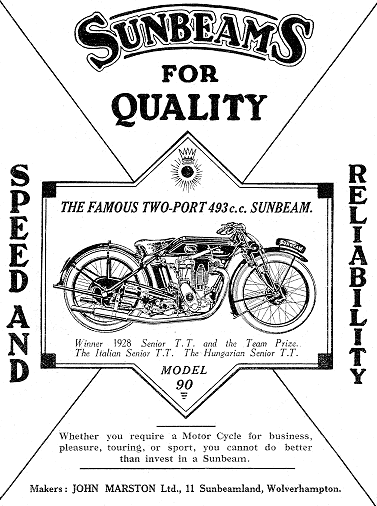
An advert from 1928.
| In November 1929 production of the Deloford portable boat
began in an empty workshop on the top floor. The boat, made of
plywood and rubberised sheet, could be packed flat for easy
transportation. A lot of orders were received, the venture
appears to have been a great success. |
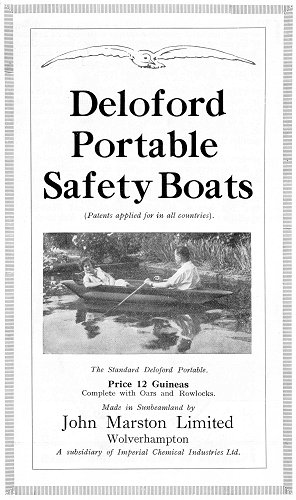 |
|
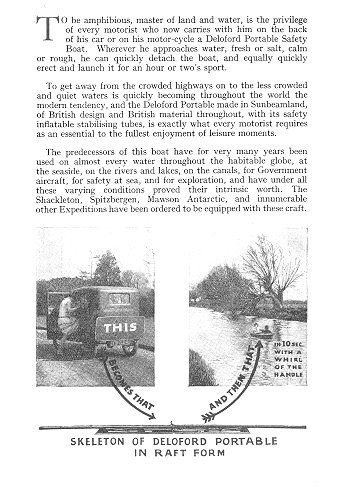 |
|
The first
and second pages of a Deloford leaflet. |
|
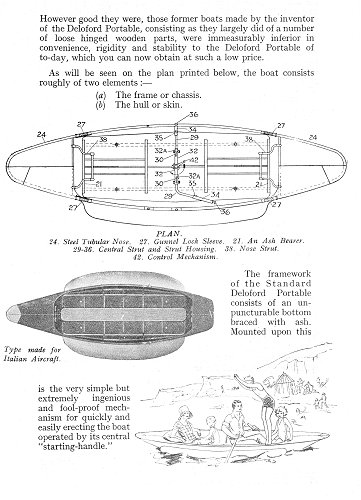 |
|
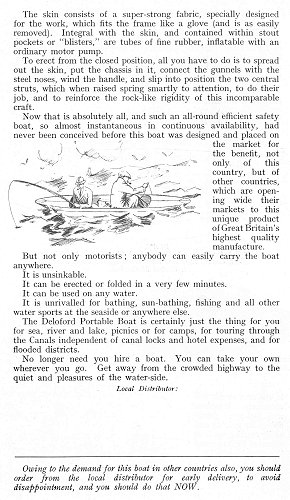 |
|
The third
and fourth pages from the Deloford leaflet. |
|
|
In 1929 Sunbeam finally adopted
the saddle tank, which had been invented by Howard Davies in 1924. It
was a significant year because
Charlie Dodson won the Senior T.T. for the second year running, at an
average speed of
72.05 m.p.h. He also made the fastest lap in
30 min.47 seconds at a record speed of 73.55 m.p.h.
Team mate Alec Bennett came
second and Arthur Simcock finished in seventh place. To cap it all
Sunbeam also won the team prize for the third year in succession. Sadly
this was the company's last successful Isle of Man T.T.
1930 started badly. Sidney
Bowers was taken seriously ill, and on January 26th, replaced by
accountant Graham Bellingham. Sales were falling because of the
depression, and a new range of models was announced in readiness for the
Motorcycle Show. Sidney Bowers' departure
heralded the start of many changes that would take place at the works
during the next few years, beginning with a costing exercise in the form
of a time and motion study. |
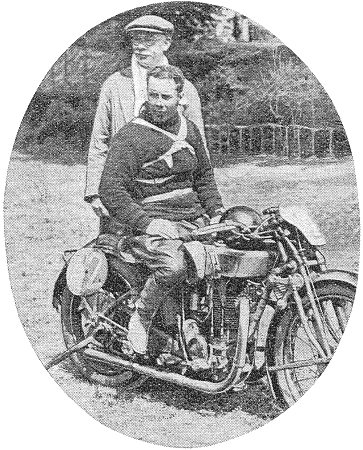
John Greenwood (standing) and Charlie Dodson,
after his T.T. win in 1928. |
| The inspection was carried out by experienced employees who
timed and checked all operations and procedures. This must have
worried many of the 600 staff. The
study led to a rationalisation process which ended many of the
old-fashioned, uneconomical processes, such as the large amount of
hand soldering of components. For the first time many components
were purchased from other manufacturers rather then made in-house.
One of the conclusions of the study was that many of the machines
were worn out, but as investment was not a priority at the time,
nothing was done about it. |
|

Mark Homer's Sunbeam Lion. |
A number of changes to the
range of models took in 1930. The Model 6 'Longstroke' was
restyled and called 'The Lion', which was named after one of the ICI
trademarks. The design of the fuel tank was a departure from usual
Sunbeam practice. The soldered petrol tank was replaced by a
bought-in welded and chrome plated tank.
There was also the new
344 c.c. Model 10, which had an overhead valve engine, and
was designed by Stephenson and Greenwood. It had a three speed
gearbox, was lightweight and economic on fuel. Fuel consumptions of
over 100 m.p.g. were not uncommon.
In the new range, the
Druid-type forks were replaced by Webb-type centre spring forks, and
soldered petrol tanks were discontinued (except on the Model 90)
in favour of the welded, chrome plated bought-in type that was
fitted to the 'Lion'. |
|
In 1931 prices were reduced due to the
continuing depression, and the company adopted more internal
economies in an attempt
to reduce manufacturing costs.
Sunbeam machines continued to take
part in trials events, but racing was discontinued. George Dance left
the company and moved to Diamond Motors, and then went into market
gardening.
August 1931 saw the introduction of
a 2-stroke outboard motor for boats. There were
three versions, a 340 c.c. twin, a 102 c.c. single, and a 78 c.c. single.
It was produced
at Wolverhampton for several years, and distributed by Merlyn
Motors, Whiteladies Road, Bristol. It became known as the 'Seagull'
outboard motor. |
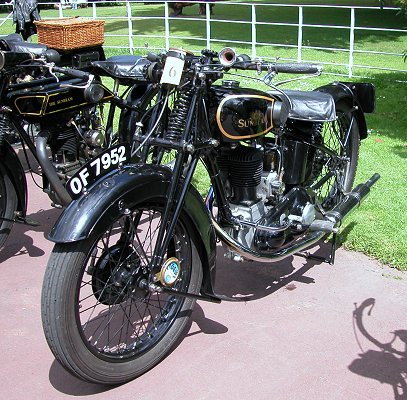
John Grew's Model 6 from 1930. |
|
The 78 c.c. and 102 c.c. versions were tested on
the Staffordshire and Worcestershire Canal at Coven, near Three
Hammers Farm. The 102 c.c. version was also tested on the River
Severn. The 340 c.c. model was tested on the River Severn, near
Lincoln Weir, Holt Fleet, Worcestershire. The engines were
tested by G. E. Greenwood (son of John Greenwood), and F. W.
Matthews. |
|
In 1932 only minor changes
were made to the models. New detachable and interchangeable wheels
were fitted to all models along with a 4-speed constant mesh
gearbox. Sales continued to fall and more economies were introduced
at the works. Most of the spares were sold off
In a further attempt to
reduce manufacturing costs, the 'Lion' was revamped with a detachable
cylinder head, and the Model 90 only produced in small numbers,
because it was expensive to build, as much of the machine was hand
fitted. The Model 10 was dropped, and the old 350 c.c. Model 8
reintroduced.
John Greenwood, known in the
works as 'Cherry' Greenwood because of his red nose, retired in
April 1934. As chief designer he had been the leading light behind
the Sunbeam designs,
Sales were still falling and
a re-assessment of the cycle and motorcycle production began at the works.
By the summer of 1934 motorcycle sales had greatly declined, but
bicycle sales had doubled, so more emphasis would be placed on
bicycle production. Around the same time it was decided to greatly
increase, and fully mechanise radiator production. As a result, many
of the buildings in the factory yard were demolished and replaced in
August and September by a range of modern assembly bays.
The
writing was now on the wall for the cycle and motorcycle part of the
business. |
|
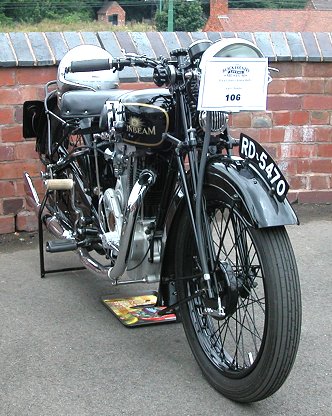
R. J. Cook's Model 8 from 1935. |
At the 1934 Motor Cycle
Show, Sunbeam introduced the 'High Camshaft' Model 16. It was
designed by George Stephenson and had a duplex cradle frame, Burman
gearbox, and powered by a
249 c.c. engine. It sold for £49.10s and was
in production for about 12 months. Unfortunately sales of the
machine were not good, due to competition from other manufacturers,
particularly Velocette.
The 1934 catalogue featured
the 493 c.c. overhead valve Model 95, a top of the range machine that
sold for £95.10s and the
246 c.c. overhead valve 'Little 95' that sold
for £69.10s. There were also the 500 c.c. and 600 c.c. 'Lion Longstroke'
machines, the
250 c.c. overhead valve 'Longstroke', and the 350 c.c.
Model 8. The 1935
catalogue featured much the same range of machines as in the
previous year, but all at greatly reduced prices. |
|
Sunbeam bicycles and motorcycles were still
in the doldrums and so ICI started to look at selling their two wheeled
subsidiary. On the motorcycle side there was not too much to sell.
ICI wanted to keep the factory, for which they had other work.
There were no groundbreaking machines on the drawing board, no large
order books, and not even a production line, production lines had
never been quite the thing at Sunbeamland and the factory was not
even designed for it.
In
most years, only around 35 motorcycles were built each week. The
best year for sales was 1930 when production briefly peaked at
around 50 motorcycles a week. Although bicycles were made in larger
quantities, only 2,000 to 3,000 were made in a year, at the height
of production.
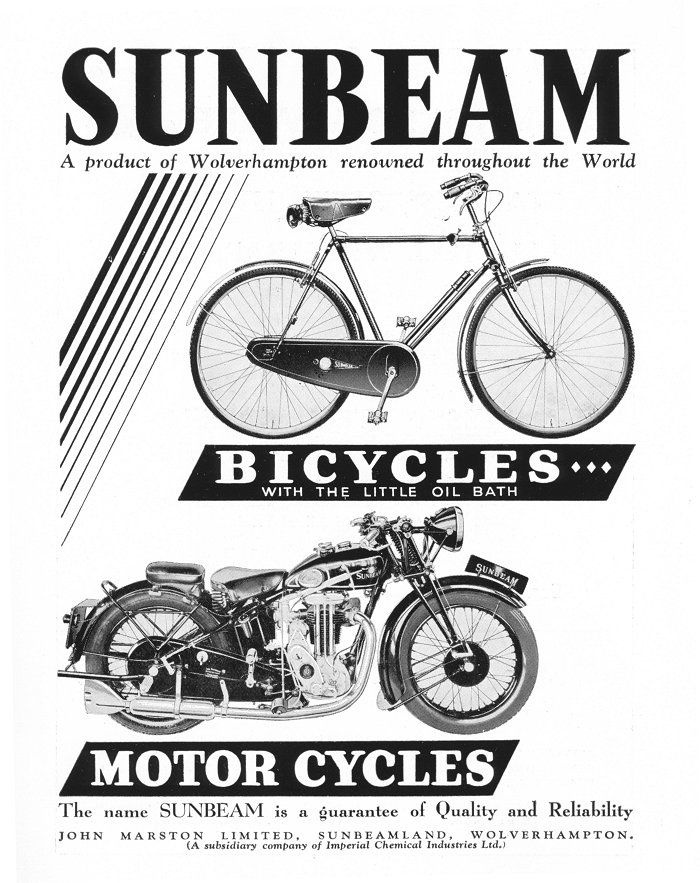
An advert from the early 1930s.
Motorcycles were always hand-built on a bench, production techniques
never improved with time. This was quite a contrast to A.J.S. which
used to be based at Graiseley Hill, where the latest machinery and
production techniques were in use, and 20,000 to 25,000 machines
were built in a good year. Because A.J.S. parts were accurately
machined, they were easily replaced when necessary. Sunbeam spares
still had to be hand-fitted, which could involve filing, or
re-drilling holes to a suitable size.
The same range of machines
remained in production in 1936 with two major innovations. All
machines now used the new duplex cradle frame and several models had
larger, improved brake drums.
During 1936 ICI continued to look for a buyer
for Sunbeam bicycles and motorcycles, and clearly caught the
attention of the Collier Brothers who ran Associated Motorcycles (AMC).
Walter Iliff, Sunbeam's Company Secretary was blissfully unaware of
this when he offered motorcycle sporting personality, George Rowley
of A.J.S. the job of Sales Manager and rider. A.J.S. had been
acquired by the Collier Brothers in 1931 and was now based at
Plumstead. George accepted the job and returned to Plumstead to
inform his employers of the situation. On his return he was told in
secrecy that AMC were about to acquire Sunbeam. He instantly wrote
to Iliff stating that he could not accept the job because he had to
give 6 months notice to AMC. This must have been quite embarrassing
for Iliff because he had already notified the press about George's
appointment.
The sale finally took place in August 1937.
On the afternoon of the sale, George arrived at Sunbeamland with an
AMC Director, the AMC Production Engineer, and the AMC Paintshop
Manager. They were clearly shocked when they looked around the
factory and saw the antiquated production techniques. None of the
machinery was of use, it was extremely old and worn-out. They
decided to transfer the large stock of components to their London
factory, along with the design data, and drawings etc. Everything
else, including the machinery, was scrapped, and the factory records
destroyed. AMC had however acquired the
customer's goodwill, the brand name, and the
dealer network. Two new companies were formed, Sunbeam Bicycles Limited,
and Sunbeam Motor Cycles Limited, and production began at Plumstead.
ICI absorbed the whole of
the cycle and motorcycle workforce into large-scale radiator
production, which was essential to secure the future of the factory.
Epilogue
Today original Sunbeam
motorcycles remain popular, and many of them are preserved
around the world. They are not only preserved, but regularly used in
rallies and vintage events, and still prove to be reliable. Although
Sunbeam got off to a slow start with motorcycle production, they
outlived most of their local rivals. When production ended in 1937,
only one of the other early Wolverhampton motorcycle manufacturers,
Wolf, was still building machines.
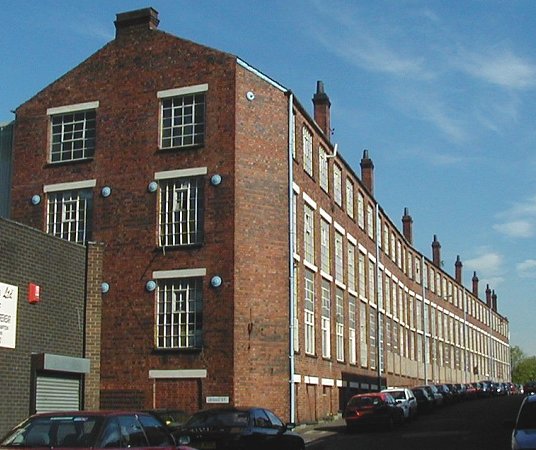
Sunbeamland, as it was several years ago.
|

|
|

|
|

|
| Return to The
Golden Years |
|
Return to the
beginning |
|
Proceed to
Sunbeamland |
|